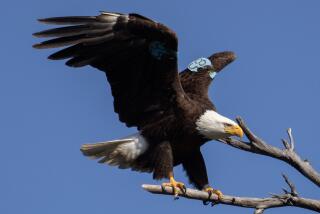Toxic diet threatens reproduction of coastal California condors, study finds
Captive-breeding programs have brought the California condor back from the edge of extinction, but habitat loss and lead poisoning have prevented a stable recovery in the wild.
Now a new study is raising more cause for concern: A wild population of condors along the central coast in Big Sur has been exposed to pesticides and other toxic substances linked to thinning of eggshells.
About 40% of breeding-age condors along the coast have been exposed to DDE, a form of the banned pesticide DDT, which is found in the carcasses of marine mammals — such as sea lions — that the scavenger birds regularly feed on.
The findings, published this week in the journal Environmental Science and Technology, also show that the coastal birds had elevated levels of polychlorinated biphenyl, or PCBs, when compared to their inland counterparts.
“It is disheartening, because I feel like future release plans — I don’t know where they’re going to release” more condors from the breeding programs, said Carolyn Kurle, co-author of the study and a researcher at UC San Diego. “The coast seemed like a good idea, but now that we showed these high levels of contaminants in birds that forage on the coast, it might not be.”
California condors typically feed on dead land animals such as deer, goats and sheep. Because biologists have hypothesized that condors fed on dead marine mammals at the end of the last ice age, many hoped that type of diet could be a healthy source of sustenance for the scavengers.
In fact, condors that spend more time along the coast have had a better chance of surviving than those living inland, due to the supposedly greater presence of lead found there.
However, the new report estimated that eggs from the shoreline condor population have a 20% to 40% lower hatching success rate than noncoastal breeders.
“They’re not reproducing in the numbers that would lead to a strong recovery,” Kurle said. “We can infer that the reproductive failure in [coastal] birds in Central California is from DDT.”
The California condor is one of the largest birds in North America, with a roughly 10-foot wingspan and weighing up to 25 pounds. Condors once flew up and down the coast from Canada to Baja California and populated states including Texas, Florida and New York.
By the early 1980s, fewer than two dozen survived in the wild, according to the U.S. Fish and Wildlife Service. By the end of that decade, the last birds were placed in captive-breeding programs at the San Diego and Los Angeles zoos.
Today, there are more than 420 condors in the world, with breeding programs in California, Arizona, Utah and Mexico, according to the U.S. Fish and Wildlife Service. Wild populations live in California, Baja California and Arizona.
More than half of the population currently exists in the wild, with about 155 birds living near release programs in Big Sur, Pinnacles National Park and Los Padres National Forest.
But the species is far from establishing self-sustaining populations.
Deaths have largely outpaced successful births in the wild, requiring conservationists to regularly release more captive-bred juveniles.
“California condors in the wild are still struggling,” said Steve Kirkland, California condor field coordinator the U.S. Fish and Wildlife Service. “We are still losing more birds to human-related causes of mortality than are produced in the wild, with lead poisoning the primary impediment to recovery.”
Other causes include hunting, electrocution by power lines, destruction of habitat and poisoning from bait meant for other animals.
In response to concerns about condor mortality, lawmakers outlawed hunting big game with lead bullets in designated ranges in 2008. But the ban has “not had any notable impact,” Kirkland said. “This is likely due to the fact that condors feed on animals shot with lead ammunition that are not covered” under that law.
As the result of further legislation, a ban on all hunting with lead ammunition is being phased in statewide during the next three years.
In the meantime, those dedicated to protecting the condors have been going to great lengths to maintain populations. In some cases, scientists have replaced compromised eggs in the wild with those bred in captivity. The birds lay an average of an egg every two years.
“When we saw this eggshell thinning, we were able to compensate for that,” said Michael Mace, curator of birds at the San Diego Zoo Safari Park. “We would take that thin-shelled egg and give a normally shelled egg to those condors in the wild. But that’s a short-term mitigation.”
joshua.smith@sduniontribune.com
Smith writes for the San Diego Union-Tribune
ALSO
Not-so-holy candle found stuffed with crystal meth
Vallejo women allegedly ‘terrorize’ fast-food workers because their food was too cold
Brush fire triggers mandatory evacuations in Fresno County, but some families won’t leave
More to Read
Start your day right
Sign up for Essential California for news, features and recommendations from the L.A. Times and beyond in your inbox six days a week.
You may occasionally receive promotional content from the Los Angeles Times.






